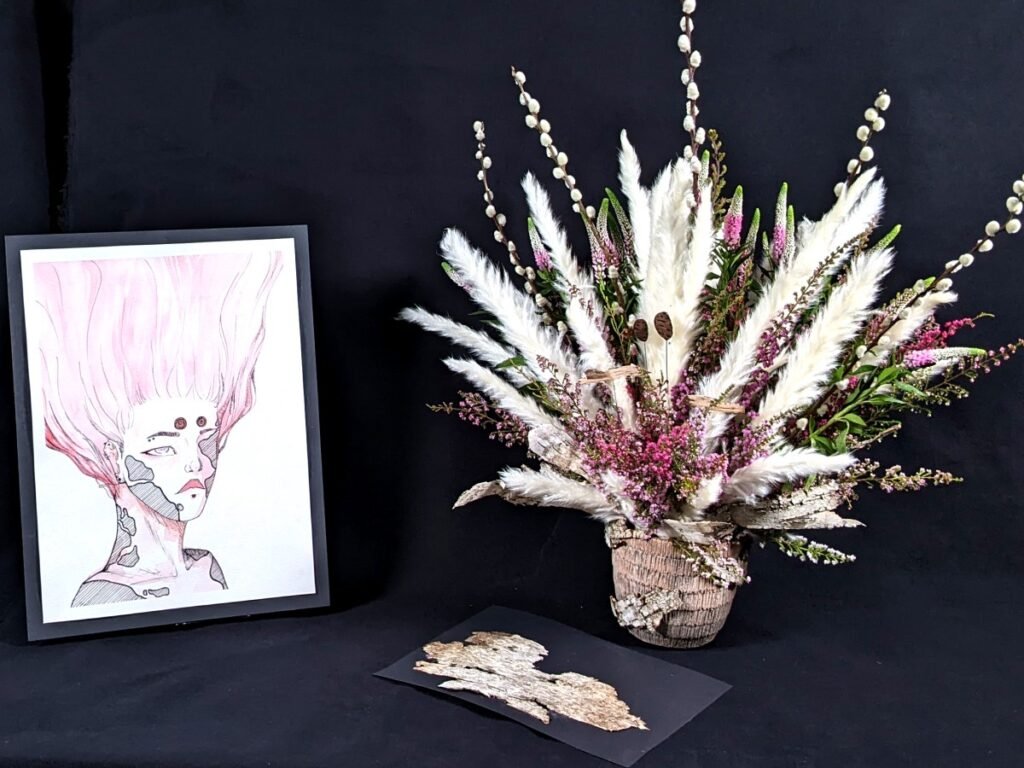Harvard Bloom N Art
Bloom N Art: A conversation between art and flowers
Article from the Harvard Press by Margaret Kusner - Published March 31, 2023

Meg Bagdonas’ creative interpretation of Sage Clowes’ watercolor is made up of white pampas grass, pink veronica, pink heather, and birch bark. (Photos by Lisa Aciukewicz)
Bloom N Art, the exhibit at Fivesparks on the weekend of March 25 and 26, was a glorious collaboration of the Bromfield School art department and the Garden Club of Harvard. Selections of student art from grades 7 through 12 were paired with members of the Garden Club of Harvard to be interpreted in floral arrangements. Approximately 350 visitors attended the exhibition over the weekend, and an additional 150 students, staff, and administrators walked over from Bromfield on Monday.
On the day before the show, the gallery at Fivesparks hummed with the creativity of the art studio. Some arrangers worked in silent concentration while others took in verbal observations. Dirt, sprigs of plants, dropcloths, and various containers were scattered about; an iron and ironing board for pressing the black backdrops were set up; and last minute adjustments were being applied here and there.
Many of the arrangers had traveled to the flower market in Chelsea to select blooming flowers, but a few used plants such as mosses, dried grasses, and budding twigs found locally.

Clem and Dion Adamy ponder Kathleen Mazzu’s three-dimensional architectural model with irregular holes as paired with a floral arrangement centered on a broken terra cotta pot by Bill Loehfelm
Standing by on easels, awaiting final positioning, was the skillful and delightfully expressive art of students. The range of art mediums and techniques included abstract and realistic painting and drawing, digital and photographic art, three-dimensional forms, printmaking, and graphic design.
On opening day, 31 imaginative, colorful, and intriguing arrangements were in final position next to the art pieces. Then the viewer could comprehend and discover the conceptual and perceptual connections in the pairings. Helpful labels listing the flowers and plant materials used in the arrangements and a program listing the names of arrangers and artists guided visitors through the exhibition.

Elise Knowles’ painted plaster mask with feathers gives a sense of flight, as does Judith Ockene’s interpretation with airy flowers: statice, freesia, and sea lavender.
Color was an obvious element that the viewer perceived, but examples of line and movement in plants and art was also evident. The textures in the plants were contrasted or reflected in the art. For example, the blond hair in a photograph or in a drawing was reflected in golden dried grasses or feathery plants in the arrangements. In another example, the shape of a fern in one arrangement reflected the shape of a pine tree in the painting.
Some of the pairings were powerful conceptually. In a pairing with a three-dimensional mask featuring wings, the arranger created a sense of soaring flight with a spare, airy arrangement of small delicate flowers. In another pairing, an orange, three-dimensional construction composed of graduated amorphous shapes was paired with an arrangement of overlapping pieces of a broken terra cotta pot, thereby suggesting deconstruction.
Even the containers were thoughtfully used in interpreting the art. For instance, three ceramic jars in one arrangement reflected the three stucco arches in the painting; or in another pairing, three square glass containers reflected the three versions of a square woodblock print.
The show, with its intergenerational aspect, contrasted art’s desire to capture time with the ephemeral quality of nature in bloom.
This event was supported by a grant from the Mass Cultural Council.

Maria Day leans in for a closer look at Karen Green’s creation, which included reindeer moss, dusty miller, orange anemones, fungi, and dried leaves to recreate digital photography by Elli Labbe, Theo Bradley, and Oscar Pride.

Pussy willow branches draw observers into Nancy Weber’s arrangement in the same way the hand draws the viewer’s eye to the eye in the center of Ien Ruark’s charcoal and pencil drawing.


Joshua Iverson’s floral arrangement included a live goldfish to reflect the tempera painting by Gabriella Temps.